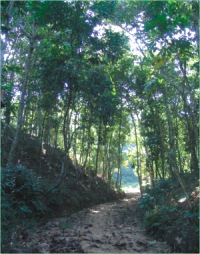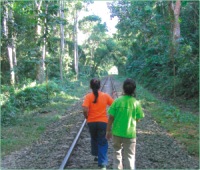Seo Master present to you: THE first thing you will probably get to know about Lawachhara reserve forest is it is a place where the film "Around the World in 80 Days" by Michael Todd was shot.The forest lies northeast of Srimongol, Sylhet. It is one of the three moist forests left in Bangladesh and invites you to explore and discover. Leave the main road from Srimongol and enter the reserve forest through a bumpy brick road that guides to the forest department office and the railway line. Budget | | Participants must reach Dublar Char at least two days before the festival. Tourists may hire boats from Mongla, but they have to take permission from the forest department. Our advice is to go with the tour operators. Guide Tours Ltd and Bengal Tours operate trips to the festival from Dhaka. The cost for a four-day trip including accommodation, transport, food and guide would be between Tk 5,000 and Tk 4,500 per person. | Thingstocarry | | Light-soled shoes Warm cloths Sun screen lotion Sunglasses Sun hat Binoculars Insect repellant Flashlight Camera gears | We cross the rail track at the very shooting place of "Around the World in 80 days", follow the obviously often used path leading into denser woods. Shortly afterwards, we leave the trail, choosing the first small path heading left, northwards. Prominently, a teak tree stands exposed, close to our way through the dark greens. Rays of sunlight enter, dispersed by the Civit and Garnary tree canopy. Like tiny spots, they sparkle on spider webs, some old, some being woven at that very moment, horizontally over the path. We have been following the path for less than a kilometer. Before us, a small creek spreads over the path. Sediments color its water reddish. Tadpoles lazily hang in the shallows, some dragonflies buzz over the pond. On the soft mud, we find footprints of a civet cat. Continuing our exploration, we hold right to the next fork as the path gets narrower. Dew keeps on dropping on our heads, leaving a dotted pattern on the sand. Imprints of human feet remind us of people frequently entering the forest, exploiting its resources. We find interesting types of spiders on the trail. One, we discovered, had two long backward pointing horns in the rear. When pointing downwards, they look like balance stick artists on the rope. But when pointing upwards, they resemble enormous scorpion stingers. In the dewy morning air, butterflies flutter or take sun-bath. Termites have built colonies along tree trunks, making intricate patterns. From further away, a gibbon family suddenly starts screaming at their top of voice. Lawachhara forest is one of the rare places where white-browed gibbons still can be seen in the wild. Three groups of about 20 gibbons live here, among other monkeys and lagurs. But for the moment, they would not show up. Invisible as they are, it seems that the forest department has rather set up a surround sound effect to fool the visitors. Continuing our exploration, we hold right to the next fork as the path gets narrower. Dew keeps on dropping on our heads, leaving a dotted pattern on the sand. Imprints of human feet remind us of people frequently entering the forest, exploiting its resources. We find interesting types of spiders on the trail. One, we discovered, had two long backward pointing horns in the rear. When pointing downwards, they look like balance stick artists on the rope. But when pointing upwards, they resemble enormous scorpion stingers. In the dewy morning air, butterflies flutter or take sun-bath. Termites have built colonies along tree trunks, making intricate patterns. From further away, a gibbon family suddenly starts screaming at their top of voice. Lawachhara forest is one of the rare places where white-browed gibbons still can be seen in the wild. Three groups of about 20 gibbons live here, among other monkeys and lagurs. But for the moment, they would not show up. Invisible as they are, it seems that the forest department has rather set up a surround sound effect to fool the visitors.  Following the path, we approach a different tune, getting louder and louder. An alarm clock? A cell phone? Beeping constantly loud and high, almost painful to our ears. Crickets. We leave the "natural noise" behind us. Suddenly, we hear a ruffle above us. Quickly, a black fur appears between leaves and branches, just to disappear again: A rare orange-bellied Himalayan squirrel.The trail carries on and we realise hours have passed. The last thing you must know about Lawachhara forest is it is endangered. Deforestation continues and its treasures are getting depleted. Following the path, we approach a different tune, getting louder and louder. An alarm clock? A cell phone? Beeping constantly loud and high, almost painful to our ears. Crickets. We leave the "natural noise" behind us. Suddenly, we hear a ruffle above us. Quickly, a black fur appears between leaves and branches, just to disappear again: A rare orange-bellied Himalayan squirrel.The trail carries on and we realise hours have passed. The last thing you must know about Lawachhara forest is it is endangered. Deforestation continues and its treasures are getting depleted. 2013, By: Seo Master
|








![]()